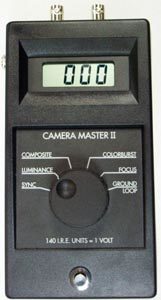VIDEO LUMINANCE MEASUREMENT AND THE I.R.E. FILTER
VIDEO LUMINANCE MEASUREMENT AND THE I.R.E. FILTER
By: Don McClatchie, FM SYSTEMS, INC.800-235-6960
Television video has been in wide use since the early 50s. Back then the video signal was black and white, and the level was measured in volts, one volt peak-to- peak was the correct signal level for video at it’s brightest point. In the old days you could use an oscilloscope or waveform monitor to measure this level. Basically any wide-band instrument could be used to measure the peak-to-peak level of a video signal and there was no such thing as an I.R.E. filter.
In the late 60’s a way of transmitting color pictures came into wide spread use. This color picture signal was compatible with the black and white TV sets and also delivered color to the new color TV sets.
The organization that developed the standard for color TV was called the National Television Standards Committee or NTSC. The new color TV signal was just like the old black and white TV waveform with the addition of a chrominance signal at 3.58 MHz to carry the color information. With the addition of the chrominance signal the video signal could no longer be measured like the old black and white signals. In fact, a new measurement process was developed using a term called the I.R.E. unit and new procedures for measurement. One I.R.E. unit is equal to .007142857 Volts peak to peak.
The NTSC procedure requires that a special filter be used in the measurement path of the color video signal. That filter is called an I.R.E. filter, after the standards committee that developed it. The filter reduces or “rolls off” the chrominance signal so that it does not interfere with the measurement of the luminance “white” signal.
Color video measured on a wide-band voltage basis like the old black and white TV signal actually measure 1.142857143 Volts peak to peak with maximum color saturation instead of the normal 1 Volt peak-to-peak. If this signal is set to 1 Volt peak-to-peak your actual video level will be 20% too low.
The I.R.E. filter is used to enable a standard oscilloscope or any wide-band instrument to be used to measure video waveform amplitude. Oscilloscope amplitude measurements of a color video waveform include the chrominance component unless filtered out by the I.R.E. filter. This chrominance component will cause the peak-to-peak measurement to read higher than the actual luminance waveform by a variable factor dependent on color saturation.
Failure to use an I.R.E. filter on an oscilloscope or any wide-band instrument when measuring video amplitude will cause a variable reading error of up to 20%. The I.R.E. filter removes the chrominance signal that is the source of this error.
If you are using a video waveform monitor to measure your color video signal it should have a setting that will put an I.R.E. filter into the video path to correctly measure the luminance level.
The important thing to remember is that if you are measuring color video with a wide-band instrument be sure that you have an I.R.E. filter in the video path. If you have the need for an I.R.E. filter one is available from FM SYSTEMS, INC. It is called the IRE-75. Call 800-235-6960 and order one.
There is a video test meter that makes the luminance level measurement using the required I.R.E. filter called CM-2 CAMERA MASTER. This meter will measure the SYNC, LUMINANCE, COMPOSITE, COLOR BURST, FOCUS, and GROUND LOOP in I.R.E. units per NTSC standards. It is a hand-held portable low cost meter for all video applications. Click On this link to see More information about this meter.

CM-2 Video Master Test Meter


